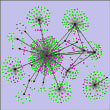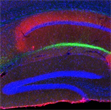Monday, 24 November 2014
Persistence of social signatures in human communication

No need to be impressed anymore by people who have 600 or 1400 “friends” on Facebook. Just like you and I, they are not really discussing their true feelings or anything else important with more than one or two dozen people at most. And for every individual, the size of this limited “hard core” of relationships seems to persist over time, even though the friends who compose it may change. These fascinating cognitive data come from a study entitled “Persistence of social signatures in human communication”, published in the journal Proceedings of the National Academy of Sciences of the United States of America in January 2014. (more…)
From Thought to Language | Comments Closed
Wednesday, 5 November 2014
A Brain Circuit That Links Two Events in Time

If you’re out in a storm and you see a bolt of lightning streak across the sky, you tend to pull your head down between your shoulders for the next few seconds, fearing the big thunderclap that you expect to come next. This kind of association between a stimulus and a potential danger is something that the human brain retains easily, because it has always had an obvious importance for our survival.
A study co-ordinated by MIT professor Susumu Tonegawa and published in the journal Science in January 2014 reveals the neuronal bases of this association between a stimulus and the timing of a potential danger, about which relatively little was previously known compared with the association with the other essential property of a danger: its location. In the latter case, the hippocampus, the key brain structure for encoding memories, makes use of place cells, which are activated when you are in or are remembering a specific location. (more…)
Memory and the Brain | Comments Closed







